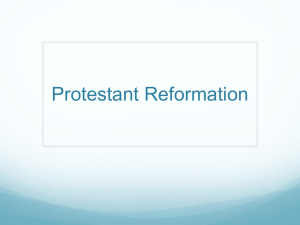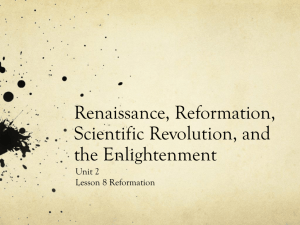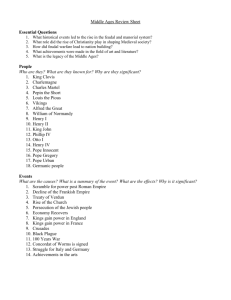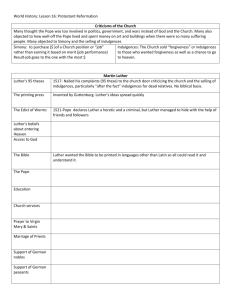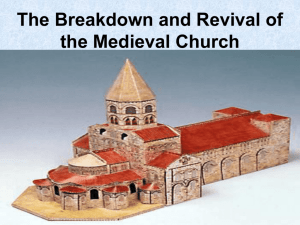Decline in the Medieval Church
advertisement
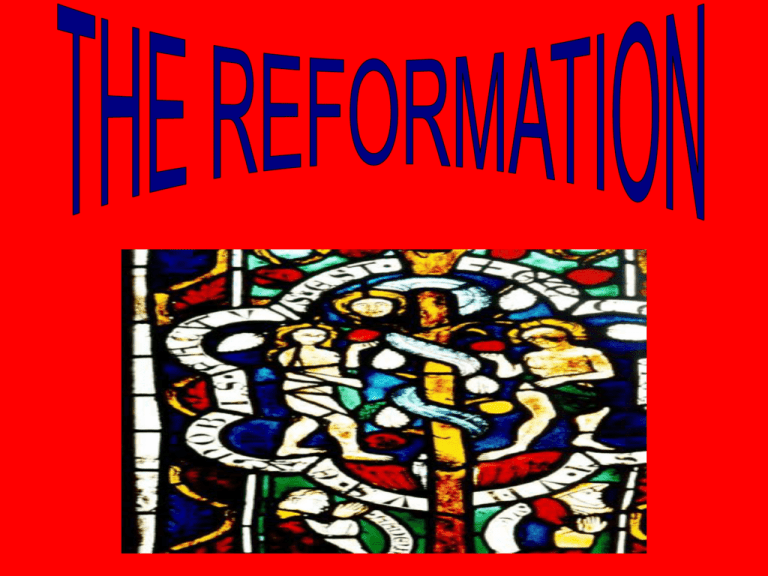
Decline in the Medieval Church Spiritual Authority Political & Spiritual Poverty Temporal Authority Taxing the clergy: Boniface VIII v. Philip [clericis laicos] - 1296 Royal courts vs. Church courts Papal Bull [Unam Sanctam] - 1302 Marsilius of Padus [Defensor Pacis] - 1324 Specific Crises 1. New Heresies. 2. Schism. 3. Lay Reform. 4. Conciliarism. Decline in the Medieval Church Official Church Beliefs Theological Difference s Heresies Teach contrary to accepted doctrine John Wycliffe • Lollards • John Huss • Hussites Schism leads to new movements • Schism allows people to question papal authority – Bible as a guide – Wycliff- unworthy pope did not have to be obeyed stressed faith. No Transubstantiation • Convicted as heretic in England – Hus agrees with Wycliff – Also convicted as a heretic burned at the stake The Hussite Wars [1420-1436] Decline in the Medieval Church Conciliarism, or the conciliar movement, was a reform movement in the 14th and 15th century Roman Catholic Church which held that final authority in spiritual matters resided with the Roman Church as corporation of Christians, embodied by a general church council, not with the pope. Popes Innocent III Boniface VIII The Avignon Papacy [1309-1377] Internal Church Power Church Councils [Conciliarism] Pisa Constance Basel UNAM SACTUM • Started as a fight between King of France (Phillip IV) and Pope (Boniface VIII) over taxes. • Phillip arrests Boniface who dies shortly thereafter • Phillip arranged for the election of Clement V (French) placed in him Avignon. – Allows for French influence over the Papacy – Avignon papacy last from 1309-1378 The Great Schism: 1378-1417 The Great Schism • 1378 Pope Gregory XI returns to Vatican to try to restore peace. • Dies later that year • A group of Cardinals choose new Pope Urban VI – – – – Picked for his faithfulness to Avignon Papacy Romans invade proceedings and Cardinals flee Urban shuns Avignon Cardinals see him as unfit select new Pope Clement VII, sets up shop in Avignon – Urban still in Vatican ONE CHURCH TWO POPES • Divided Popes look to create alliances. • Become political • Avignon Pope supported by France, Castile, Scotland • Roman Pope supported by HRE, England, Portugal and most of the Italian States • RELIGION IS NOW DIVIDED FIGHTHING FOR POWER The Council of Pisa • • • • Trying to clear up Papacy issue Council picks new Pope (Alexander V) Other Popes refuse to resign Popes become pawns in Rulers power struggle • Finally ends with the election of Martin V • By Council of Constance (1418) The Avignon Papal Complex The Spread of the Printing Press Prior to the Reformation all Christians were Roman Catholic The [REFORM]ation was an attempt to REFORM the Catholic Church People like Martin Luther wanted to get rid of the corruption and restore the people’s faith in the church In the end the reformers, like Luther, established their own religions The Reformation caused a split in Christianity with the formation of these new Protestant religions Martin Luther John Calvin Henry VIII The Spread of Lutheranism Lived from 1483-1546 in Germany Father encouraged him to study law A sudden religious experience inspired him to become a monk He became troubled over the possibility of not going to heaven He turned to the Bible, and confession for comfort In the Bible he found the answer he was looking for “The righteous shall by his faith.” Luther realized that only faith (in the ultimate goodness of Jesus), not good deeds, could save a person. No good works, rituals, etc. would save a person if they did not believe. A list of things he thought were wrong with the Catholic Church (95 Complaints) He criticized: The Power of the Pope The Extreme Wealth of the Church Indulgences (Catholic concept of Salvation) Gutenberg’s Printing Press made it possible for Luther to spread his beliefs Posted his 95 Theses on Church doors in Germany Gained support from people and criticism from Church •The first thing printed on Gutenberg’s press was the Bible. •This is a picture of a page from one of Gutenberg’s Bibles. The Diet of Worms 1520 Pope Leo X order Luther to give up his beliefs Luther burned the order and was excommunicated Luther went into hiding where he translated the New Testament into German – spreading his beliefs even further He was the Pope during the height of the corruption “I am fed up with the world, and it with me. I am like a ripe stool, and the world is like a gigantic anus, and so we’re about to let go of each other.” -Luther The Peasant Revolt - 1525 Some Local German Churches accepted Luther’s ideas Lutheranism was formed Supported by German Princes who issued a formal “protest” against the Church for suppressing the reforms The reformers came to be known as [PROTEST]ants - Protestants Anti-Catholic Influenced by Martin Luther Disagreed with Luther’s “Salvation through faith alone.” Created his own Protestant religion in Switzerland Calvin believed in: Salvation through Predestination At birth it is decided if you will go to heaven or hell Foreknowledge God knows everything that will happen in your life Purified approach to life: No drinking, swearing, card playing, gambling etc.. Started in Switzerland – Calvinists England = Puritans Scotland = Presbyterians Holland = Dutch Reform France = Huguenots Germany = Reform Church Calvin’s World in the 16c Presbyterian PuritanHugeunots The Anabaptists Dutch persecution of Anabaptists (Mennonites) Henry VIII 1491-1547 • Became king at 17 • Son of Henry VII and Elizabeth of York. • 14yrs- did not want to marry Catherine of Aragon. • Arranged marriage to brother’s widow. (Arthur) Henry VIII was the son of Henry VII Married Catherine of Aragon Widow of Henry’s brother Arthur Catherine failed to give him a son, Henry wanted a divorce, pope said “no” Starts conflict that continues today The Act of Annantes The Act of Appeals The Act of Supremacy Executions 1532 Stopped all payment to the Catholic Church 1533 Ended Rome’s Religious hold on England 1534 Made Henry VIII the head of the Church of England Any subject who wouldn’t denounce the Catholic Church Pope will not grant annulment (Clement VII) Henry’s Lord Chancellor, Sir Thomas More sides with Pope. Henry VIII splits with Church puts himself at the head of new church • Henry started a battle with the church • The Act in Restraint of Appeals (1533) • Passed the Acts of Supremacy (1534) • Said the King controlled Church • King only supreme head on Earth • Forced people to take Oath of loyalty (Act of Succession 1534) • Thomas More refused (Beheaded) • Thomas Cramner takes Over for Wolsey (grants divorce) Six Wives • Wife # 1 - Catherine of Aragon – Married for 24 years – Pregnant many times but only Mary (1516) survived. Died 8 Jan 1536 Wife # 2 - Anne Boleyn – Secret affair with Henry – Married after Catherine was banished. – Had a female child named Elizabeth. – May 19 1536 Beheaded. • Wife # 3 - Jane Seymour – October 1537 Edward was born – 12 days after she died. Wife # 4 - Anne of Cleves - Married in Jan. 5 1540 - Less than 20 days marriage annulled Wife # 5 - Katherine Howard - Married at 15 - “Perfect” but not really - affair, beheaded on Feb.1542 Wife #6 - Katherine Parr • July 12, 1543 married • Aided Henry cause of old age. • No kids w/Henry • Did not get along with other children. • Died from childbirth problems. Religious conflict continues after his death and the death of his only son, Edward. Mary I (Bloody Mary) wants to revert back to Catholic, kills hundreds of Protestant leaders in the process Elizabeth (Protestant by birth) tries to find a middle ground. Tower of London from the Air Tower of London: The Bloody Tower Traitor’s gate Tower green Henry’s Deathbed Edward VI [r. 1547-1553] Lady Jane Grey “Ruled” England from July 10–19, 1553 Catholic Reformation • Pope John Paul III wanted to push back the Protestant tide and restore Catholicism in Europe. • Reformed the Church by using new punishments to control corruption, refined the papacy. • Built the Inquisition and strengthened education, so that the new council could fight against Protestant teachings. • Re-built the Catholic Church and spread Catholic teachings across Europe, Africa, and the Americas. • The Catholic Church became strong once more, pushing back the Protestant wave.
